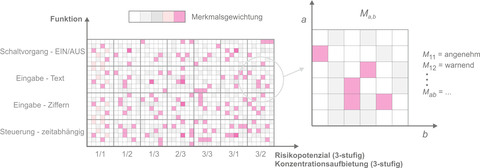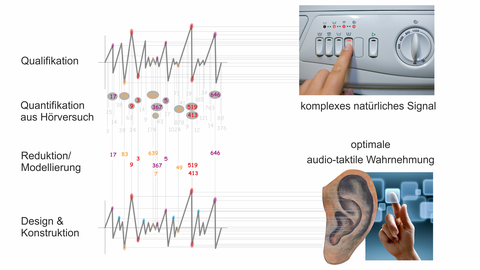Perception quality of controls
Increasingly, classical keys consisting of mechanically moving individual parts are to be replaced by compact, planar and material-integrated operating elements. The aim is to have control panels with the lowest installation depths, which can be completely integrated into front panels or cockpits, for example. A holistic control panel concept, which includes not only the plastic-based support structure but also material-integrated sensors and actuators, opens up new dimensions of design freedom. In order to meet the requirements of a complex control activity, the low tactile feedback - known from touchpads - has to be supplemented by additional measures on a tactile and auditory basis. For the perception of the function trigger different sensory channels with context-dependent, different processing power are available, which can be targeted.
Currently, keys are used as controls in all areas, from domestic appliance technology to vehicle technology. Not only their breadth of application, but also their functions have multiplied over time, so that the optimal adaptation to human activity, in addition to the simple functionality, has a particularly high priority.
Adaptation must take into account the application context (e.g. light switch, electromechanical key on the computer keyboard or window lifter in the vehicle), safety relevance and in particular the action-function-response relationship as well as the user expectation. In this context, the quality of the auditory, tactile and visual feedback of controls gains in importance. The example of a touch-sensitive touchpad illustrates that there is often uncertainty whether a process has been triggered successfully or not.
Plenty experience exists in the field of sound synthesis and sound design. These experiences were used in the audio-tactile feedback supplement, e.g. for touch screens.
The expectation of users when operating a control element is highly context dependent. These contexts can be categorized for example according to functionality, risk potential and concentration effort (see figure meaning matrix).

Bedeutungsmatrix
An example may be the operation of the hazard warning lights button in the vehicle cockpit in the situation of congestion on the highway. In this situation, the operator has to minimize the risk of causing a collision by putting his full concentration into action as quickly as possible. In this scene, the driver's visual and tactile sensory channels are heavily loaded. He should observe the distance to the car in front as well as taking into account the rear-view mirror information with the distance to the following vehicle. In this situation it will be difficult to monitor the function of the hazard warning lights. The tactile sensory channel is also heavily challenged by steering and braking functions. In contrast, the auditory sensory channel has sufficient perceptual capacity. Here, the feature "reliability" is weighted much higher than for example the feature "pleasantness".
A study examined the overall quality, feedback capability and error rate of touchscreen usage in relation to various auditory, tactile and audio-tactile additional stimuli. As tactile stimuli, button-like time functions and shocks as well as additional synthetic higher-frequency vibrations were generated via an electrodynamic shaker. A button-unusual stimulus of 50 Hz caused an equally well improvement of the above-mentioned parameters as usual button-like low-frequency movement stimuli. This result shows that the freedom of design for tactile stimuli goes well beyond the level of classic key movements. Through the interaction of auditory and tactile stimuli another feedback improvement could be detected by synergy effects. However, these synergy effects only occur in certain audio-tactile stimulus combinations. Auditory stimuli proved to be particularly favourable in the form of two pulse-like signals which follow one another for a short period of time.
New developments in the generation of haptic vibrations enable increasingly invisible and space-saving integration in user interfaces. Piezoelectric shakers are a promising technology for this. This technology is lightweight, can be installed in an extremely space-saving manner and has a low energy consumption. In addition, they have very low latency and can generate higher forces than electrodynamic shakers of the same size.
Contact
Mitarbeiter
NameMr Ugur Alican Alma M.Sc.
Send encrypted email via the SecureMail portal (for TUD external users only).
Professur für Akustik und Haptik
Professur für Akustik und Haptik
Besucheradresse:
Barkhausenbau, Raum BAR 58 Helmholtzstraße 18
01062 Dresden
None

